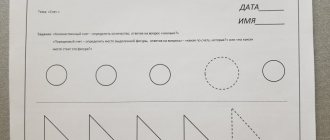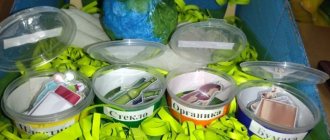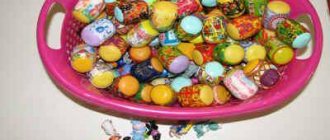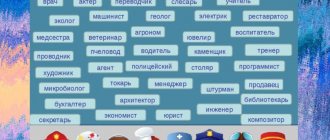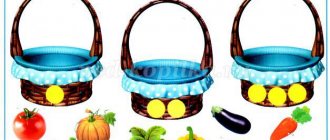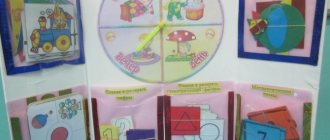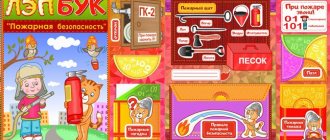DIY educational games
It would seem that now you can buy almost any toys.
Why reinvent the wheel and engage in amateur activities? But games made by mother’s hands always enjoy special love from the baby, and even if they turn out not quite perfect, they are certainly original and with a considerable share of mother’s warmth and love. Plus, in the current uncertain economic climate, homemade toys can help you save some money to buy something more worthwhile, like children's books.
I admit that I do not belong to the category of handicraft mothers, rather the opposite. But with the birth of my daughter, the situation suddenly changed: I wanted to create something (or at least try to do it), tinker, invent. As it turned out, this requires a minimum of time and material costs, and the child’s enthusiastic reaction is the most pleasant reward.
Tactile bags
To make them you will need some colorful scraps and various fillings: cereals, beans, pebbles, rustling polyethylene, cotton wool, salt, small coins, etc. It is advisable to choose fabric of bright colors and different textures. You can also sew two-color bags.
Just cut out squares from the fabric, for example, 8x8 cm + 0.5 cm for allowances on each side. Sew the bags, leaving a small hole, turn them inside out, fill them with stuffing and sew up the hole. The baby will be interested in exploring rustling, ringing, crispy bright toys.
Developmental games for developing thinking and hand motor skills
15. DIY activity “Traffic Eater”
16. Developmental activity “Spread the seeds on watermelons”
Make watermelon slices as shown in the photo. Now the child must arrange the seeds into a certain amount. In this game, children quickly learn to count.
17. Developmental “Palms” Learning to count.”
Throw the dice and select the number on the side of the cube, bending your fingers over your palm.
18. DIY educational game “Find a match and arrange according to the picture”
19. Developmental “Making a face. Find a match"
20. Developmental activity “Making bugs out of plasticine”
21. Developmental “Learning letters and looking for matches”
23. DIY educational toy “Book for fine motor skills”
Nowadays they sell a lot of developmental boards for fine motor skills. But, dear mothers, you can make one yourself, as shown in the picture. Of course, you will have to spend more time, several hours. But your child will enjoy playing for many months and develop motor skills, thinking and speech!
DIY educational games and aids
I would like to show our games for the development of auditory perception, promoting the development of speech and hearing, training in the development of color perception, intelligence and memory.
I'll start, perhaps, with such a thing as auditory perception. I wrote in detail here. Montessori noise cylinders.
The age stated by Mrs. Montessori for playing with noise cylinders is 3 years and above. We started at 2 years old, adapting it to suit our age. I made only 4 cylinders under the red markings and the same 4 cylinders under the green markings.
That's enough for us for now. As practice has shown, you can start with 2-3 things to begin with. If you start carefully, your child will be unstoppable. I don’t know why, this game reminds me of our children’s “Broken Phone”.
We play like this: I show Arina how I take out and listen to the cylinder: I bring it to one ear and shake it, then I do the same at the second ear. I suggest she do the same. She listens to all 4 cylinders in turn. I ask questions: “Which one is louder and which one is quieter? What does the noise sound like? Then we try to look for the same noise among the cylinders with green markings (they contain exactly the same fillers).
I ask questions as she holds two different cylinders in her hands: “Do they make the same noise?” If the cylinder makes a different noise, put it back in the box and take another one. And so we take it out until we pick a pair.
Nikitin squares. Official site .
Nikitin squares are a wonderful tool for developing intelligence. I am also interested in the fact that the gradual solution of problems of the first level smoothly leads to the next, more complex ones. I made the diagrams in the Coral program. Download.
Of course, at 2 years old, we solve first-level problems. But, day after day, there are results. And they make you happy. First I made these squares on magnetic paper.
Nothing worked right away (even for me).
In practice, I realized that they must be voluminous and not cardboard. Therefore, I made it from foamiran 3-4 mm thick. These are very comfortable.
Foam kitchen napkins are also suitable. This is how we put it together. So far, 2-3 squares at a time.
The Nikitins have developed a whole system of classes with these things. He suggests starting by sorting by color. To do this you need to have squares of different colors. We have been sorting by color for a long time, we are no longer interested.
Cuisenaire sticks. I think no one will be indifferent to these little bars. We are no exception. At first we arranged them by color.
Then we found diagrams on the internet. Download. Upon closer examination of the diagrams, it turned out that they were complex for a 2-year-old. I began to draw diagrams “by hand” on checkered pieces of paper, having first measured the sticks themselves.
Then I drew beautiful ones in the Coral program. Download.
The game itself is a good tool for learning mathematics, quantities, and segments. Develops imagination.
Mobile development toys for children 3-4, 5-6 years old
11. Mobile development activity “Place the toys in circles”
Children have to try to see who can quickly place the objects in circles on the floor. These can be circles, ovals drawn or glued from tape. These games are suitable for holding competitions at children's birthday parties.
12. Outdoor educational game “Traces”
Children really like outdoor games, so you can cut out colorful footprints and put them on the floor or on the ground outside. The child must repeat what is indicated on the footprints. A fun game to develop mobility and thinking.
13. Mobile wiggle “Throw in the ring”
13. Outdoor educational game “Arrange objects by color.”
Prepare the game as shown in the picture. Now the child must arrange the objects into multi-colored squares according to color. Interesting idea for studying flowers.
14. Educational game with a cube
Draw hopscotch on the floor or ground. Each child should have their own path. Now throw the dice and according to the figure that appears on the cube, the child must move along his line.
Do-it-yourself educational games: Tatiana Aleksandrovna Barchan’s toy library
In April, I added to my collection of ideas for educational games made by myself. I was lucky enough to attend an amazing event organized by the “Native Path” website: a game meeting with Tatyana Aleksandrovna Barchan.
She has an unusual story: a biochemist by profession, she worked at a research institute and did not think that she would come up with and create educational games for children with her own hands. But everything turned out differently: Tatyana was asked to work with gifted children 6-7 years old, and this is where her career as a teacher and inventor of educational games began.
Now Tatyana runs the Rebus Center for Education and Creative Development, and is the author of many games that have been recognized by experts as one of the best (quality mark “Child Psychologists Recommend”).
Tatyana Aleksandrovna captivated me with her creativity and elegance of solutions for children’s development in play. I listened to her and realized that 90% of all the ideas I had read on the Internet in recent years were different variations of her games, invented back in the 90s. I wrote several sheets of paper, sketched diagrams and ideas. Now I have found the time and am ready to share some sketches with you.
DIY educational games
1) Box with tracks for a magnet . The point is that for the game you need two magnets: one larger, it is hidden under the boxes (on the other side), the second is smaller, it will walk across the playing field. We move the small magnet with the help of a large one, which is not visible. Wonderful miracle for kids.
We take a small candy box as a “playing field” (so that it is comfortable for the child to hold in his hands), add a path, obstacles, and other elements. As a variant of the game situation: the car is driving on business, you need to stop at a gas station (which element), then across the bridge to a car wash (next element), etc.
2) A bone for the dog. You need several boxes, different in size, covered with different colored paper. There is a dog who is looking for a bone (we can easily change it to a character that you have at home).
We hide the bone in one of the boxes and give a hint: “the bone is in the box between blue and red” or “in the box above the yellow one.” For older children, it can be more difficult: “not in red, but above blue.”
Aerobatics - let the child hide the bone and ask such a puzzle for you.
3) A simple thermometer model . Everything ingenious is simple! A rectangle cut out of cardboard, numbers signed, a regular elastic band inserted, part of the elastic band painted over. If you pull the rubber band on the other side, the temperature on the thermometer rises; if you pull it in the other direction, it drops.
4) Another look at puzzles for kids: cut not a rectangular picture, but a circle into sectors. It is more difficult to assemble such a mosaic on one side, but easier on the other. In any case, a useful variety for training attention and thinking.
5) Children's library . We take 12 identical boxes, make them the same color, stick a number on the spine and a picture on the cover. By the way, the old calendar can be used as a source of numbers for this and other benefits. All books are stored in a large box for 12 books. There are a lot of options for games with such a library. You can develop speech by guessing from the picture on the cover what this book is about, what the plot is, what the story is. You can train the number series: collect books in order, find which book is missing, put it in reverse order, ask for the “next to the fifth” book, etc. As soon as I find suitable boxes, I will definitely make such a “library” for us.
6) Lotto for the difference between flat and three-dimensional figures. To do this, you will need sheets for filling and the actual volumetric figures. Tatyana made them herself from a special modeling mass.
The players’ task is to determine what shape the object pulled out of the bag resembles (a button is a circle, a ball is a ball, etc.).
It is very useful to pass all geometric concepts through your hands, to feel them in the literal sense of the word.
7) Comparison problems. Tatyana suggests interpreting the “more” and “less” signs as an arrow, which always points to the little one, to the baby, and recommends starting with pairs: mother and baby.
I really like this positive “arrow” because it is usually supposed to represent a crocodile that eats those who are smaller. First we play with a full-fledged arrow: from mother-baby we move on to the number of objects, then to numbers.
Then the arrow “loses” the stick and the “more”/”less” sign remains in its familiar form. Then we continue to play with cards with the usual sign.
 Game "Capricious buyer" . We officially allow kids to be naughty???? To play you need many different figures of different colors. These are goods in a store where a capricious buyer comes.
Game "Capricious buyer" . We officially allow kids to be naughty???? To play you need many different figures of different colors. These are goods in a store where a capricious buyer comes.
On his card it is indicated what he wants to buy, but something like this: not red, not round, but square. It is necessary to remove those cards that the buyer does not like and leave only those that meet the criteria.
In this way, kids learn the basics of set theory without noticing it themselves.
I showed you only a small part of the games that we discussed at the game library (only those where I have photos). It is clear with what care and love for children all the benefits are made.
In addition to ideas for developmental aids, Tatyana generously shared her gaming experience, tips on organizing games, making durable toys (her own creations passed through the hands of many children over several years), features of mastering mathematics, reading, and pedagogical tricks.
Tatyana is an amazingly enthusiastic person; after the game library, all the participants came out with sparkling eyes and full shopping bags, because In addition to homemade games, there are already many “ready-to-play” games. I am absolutely delighted with some of the acquisitions, Pasha too ????
Do-it-yourself mathematical didactic game for the younger group
Children's development largely occurs through play. Children 2-3 years old, who are just joining the ranks of preschoolers, begin to spend a lot of time in a group of peers, gaining new knowledge. Do-it-yourself didactic games are especially valuable in preschool educational institutions. This is the warmth and care of a master who puts his soul into each child, as well as the opportunity to give children sensory development and first skills in mathematics and logic. We present to your attention a master class on creating a bright didactic game with a mathematical bias for the younger group of preschool educational institutions, which older preschoolers will also enjoy playing. The process is accompanied by pictures, so it will be easier for you to create.
Do-it-yourself didactic games - mathematics can be interesting
To make a didactic game with your own hands, you first need to prepare and, which is very important, calculate the material.
Let's call it "Harvest" - the guys will be able to put three types of fruit on three different trees, and then collect them in plates, leaving the leaves.
When the kids grow up, they will be able to play this didactic game with a different interest: count which fruits they have collected more or less, and distribute equally to all children.
For preschoolers in kindergarten, it is important not only to play, but also to learn new knowledge. In the didactic game “Let's Harvest,” preschoolers come to the idea of what kind of fruits grow on trees, what exactly these are fruits. They can tell what fruits taste like in each individual case, share their opinions about them, and this is the development of speech. Let's get started!
Creative materials
Anything you have can be useful. In total, you need to make three trees, several fruits of three types (for us these will be plums, pears and apples), three plates for them, and also, if desired, leaves. In order for children to develop their sensory skills as best as possible, it is worth making parts from different materials. It could be:
- Felt. Do-it-yourself didactic games made from this material are considered one of the best, since it is wear-resistant, has many beautiful colors and is easy to create.
- Rubber (or rubberized colored paper).
- Cardboard (thin and thick).
- Self-adhesive paper.
- A box or casket in which you can put parts of a didactic game.
- Of course, for the DIY process you will need scissors, a needle, colored threads (preferably floss), and a ruler. We also used green gouache to paint the back of the trees.
Source: https://mojdetskijsad.ru/pedagogam-na-zametku/matematicheskaya-didakticheskaya-igra-dlya-mladshej-gruppy-svoimi-rukami.html
Didactic game "Caterpillar"
Goal: to develop motor skills of the fingers through actions with objects, sensory perception, logical thinking
Game option: “Continue the row.”
Didactic manual “Finger dry pool”
Dry pool - used for simultaneous active stimulation on various points of the hands, fingers, palms; sensorimotor development, the formation of basic sensory standards: shape, size, material, weight, sound; fostering perseverance and patience in work; relieving emotional stress. It’s very simple to make: fill the Kinder Surprise capsules with various fillings (rice, peas, beans), cover them with thermal film for Easter eggs, put them in a small deep plastic container, and hide the Kinder Surprise toys at the bottom.
Ask your baby to look for various small objects or toys in the dry pool. By plunging as deeply as possible into the filler, the child’s hands are massaged, the fingers become more sensitive, and their movements become coordinated.
This manual can be used in music classes.
Didactic game “Beads from salt dough”
Goals:
- strengthening and development of fine motor skills, hand-eye coordination;
- developing the ability to combine colors;
- development of concentration; development of perseverance, accuracy, children's creativity, a sense of beauty in one's own work and the work of other children;
- learning how to work from a sample and create your own product.
This benefit can be done by the child himself, with a little help from an adult. Dough modeling really helps develop a child's motor skills. After all, a baby can change the shape of an object from a spherical shape to a square or triangular one. And, taking a piece of dough in his hands, he can feel its weight, heaviness and viscosity.
Description of the preparation of the manual:
Prepare salt dough (mix 1 cup of “Extra” salt, 1 cup of flour, 0.5 cups of cold water, leave for 2-3 hours in the refrigerator), form balls, make holes in them using a cocktail straw, leave until completely dry. The beads are ready!
Didactic manual “Place the eggs in your houses”
Goals:
- develop the ability to distinguish and correctly name the 4 primary colors;
- learn to combine a testicle with a cell, perform correlating actions (color guide); act purposefully, sequentially: from left to right, without skipping cells; develop fine motor skills of the fingers.
Description of the tutorial: Paint the cells of the egg container with the main colors and varnish them. We tie the Kinder Surprise capsules in the appropriate color.
The result is a bright and beautiful manual.
Children must arrange the eggs into houses according to their color.
If possible, name the color of the eggs and the color of the houses.
Didactic manual “Place the pencils in cups.”
Goals:
- develop the ability to distinguish colors;
- learn to combine a pencil with a glass; act purposefully, sequentially: from left to right; develop fine motor skills of the fingers.
Description of the tutorial: Cut out rectangles and pencil shapes from ceiling tiles. We cover the rectangles to the middle with squares of self-adhesive film of different colors. We paste the pencils with the corresponding colors. Fast, beautiful, economical!
"Tactile Box"
The tactile box is a teaching tool designed for young children.
Made from an ordinary shoe box, beautifully decorated with self-adhesive paper.
The box is filled with pieces of fabric of different textures: wool, fur, silk, guipure, etc. It also contains small objects: pebbles, soft toys, ribbons, zippers, laces, etc.
Children examine all the objects in the box with great interest with their hands.
The teaching aid “Tactile Box” helps children, using touch, to explore the world around them from a completely unusual point of view.
To ensure that kids don’t lose interest in the box -
From time to time you have to update the contents of the box and come up with different fillers.
The tactile box can be filled with objects that have completely opposite properties, for example: sandpaper, an iron key, pieces of foam rubber, a porcelain figurine, etc.
This manual can be used in direct educational activities, as well as in children’s independent activities (provided that it contains items that are safe for the life and health of children).
Didactic game “Find the extra traffic jam”
Means: corks of different colors and sizes.
Goal: development of logical thinking.
- Consciousness of an emotionally positive mood.
- Development of interest and motivation to action.
- Introducing sensory standards: getting to know different
- Properties of an object: size (large, small), shape (circle), color; developing the ability to alternate objects by color and size.
- Development of the motorized hand: developing the ability to perform actions with objects.
- Forming the skill of jointly completing a task: developing cultural communication skills;
- Development of the ability to understand and correctly perform tasks;
- Formation and activation of the child’s vocabulary: development of the ability to look at a picture, name the objects depicted on it, their qualities and actions;
- Development of perception: visual, tactile.
- Development of visual – effective, imaginative thinking, attention, memory, imagination.
Educational game for developing fine motor skills “Feed the piglet” with your own hands
Remedy: a soft toy (pig) and a bottle the size of the soft toy. Get mixed feed - beans, peas, corn flakes, etc.

